Gardening through time
PUBLISHED BY Paula
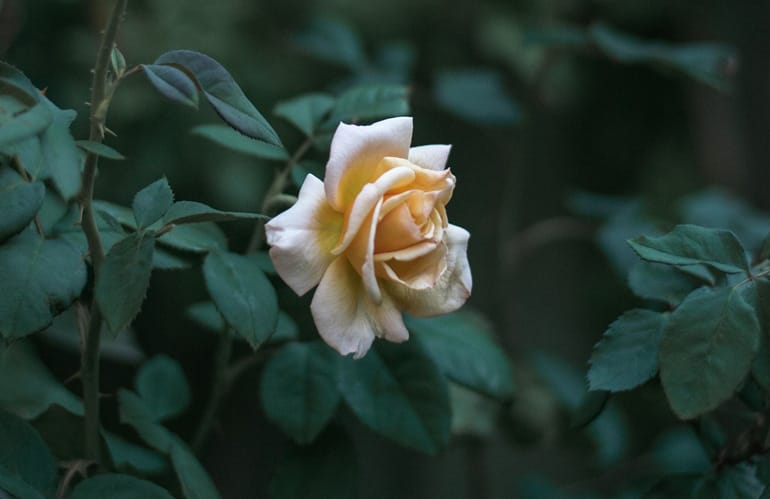
F
rom the manicured lawns of your closest National Trust property to the boxes that hang proudly beneath the windows of a London flat (despite possibly needing a little bit of TLC!), it should come as no surprise that gardening is one of the most quintessentially-English activities around.
Over time, gardening has shaped the dramatic landscape of the country; from geometric flowerbeds to oriental influences, each trend that has emerged reflects a different period in our country’s history, something that many find both captivating and fascinating.
Although you may not have green fingers yourself, it is undeniably hard to resist the allure of Britain’s gardens. Whether you choose to wander lakeside or through the topiarised lawns, there is an outdoor space calling your name and waiting to be explored. With a variety of different plant species for you to admire, no two gardens are the same.
The Hardy Plant Society , a national charity which aims to encourage interest in growing hardy perennial plants and in conserving older and less well-known plants, shared with us their thoughts on the evolution of gardening and plant conservation:
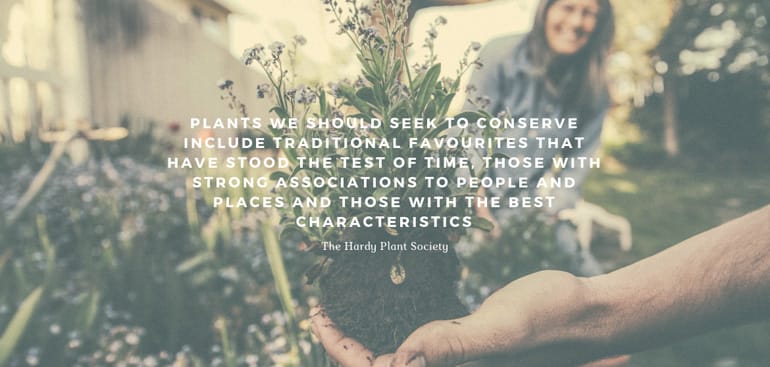
“The UK has a wonderfully rich garden heritage. Our climate and growing conditions allow us to grow a vast range of plants from many areas of the world and as a result of our being a sea-faring nation, early explorers were encouraged to collect seeds and plants to send back home. Those who could afford to wanted to grow these new plants, and we feel the same urge today when visiting an RHS Show or the local garden centre.
“With so many possibilities, garden trends come and go and so do plant fashions. Nurserymen are always looking for new and unusual plants to tempt designers and gardeners alike. But new is not always better, and while some may have more or bigger flowers they may be less hardy than older varieties or more susceptible to pests and disease. Trees and shrubs typically have a lifespan of many years, and while some perennials are long-lived, others need more attention in order to thrive. Just a few years of decreased popularity can result in plants being lost to cultivation.”
“It would not be possible or desirable to conserve all garden plants, but we should attempt to identify where to direct our efforts. Plants we should seek to conserve include traditional favourites that have stood the test of time, those with strong associations to people and places and those with the best characteristics (scent, neat growth, long flowering time). These traits will make them popular with gardeners and may give them a role in future plant breeding.”
Three Counties , the site of the RHS Malvern Spring Festival, believes that gardening has become more accessible than ever: “Gardening in the early days was a means for survival, with forest gardening being the first form of cultivation. As time progressed, a typical garden was the kitchen garden. These structural gardens were found in monasteries and designed for growing vegetables and medicinal herbs. From the 14th century onwards, gardens then became something to show off. Wealthy people filled their gardens with beautiful sculptures and fountains, creating spaces designed to amaze and inspire.
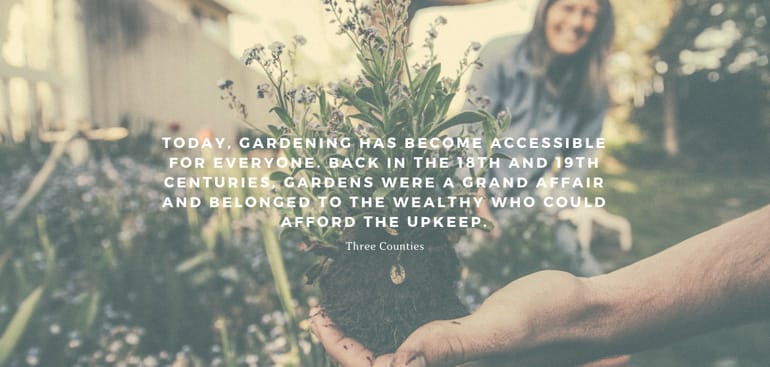
“Today, gardening has become accessible for everyone. Back in the 18th and 19th centuries, gardens were a grand affair and belonged to the wealthy who could afford the upkeep. But now, you don’t even need a garden to be gardening - these days we’re bringing the outdoors in. Those without gardens at all are still able to get their fingers green with the introduction of window boxes and houseplants.”
Throughout the years and as the climate has changed, gardens across the country have evolved, creating a colourful and charming landscape for all to enjoy.
The 1500s
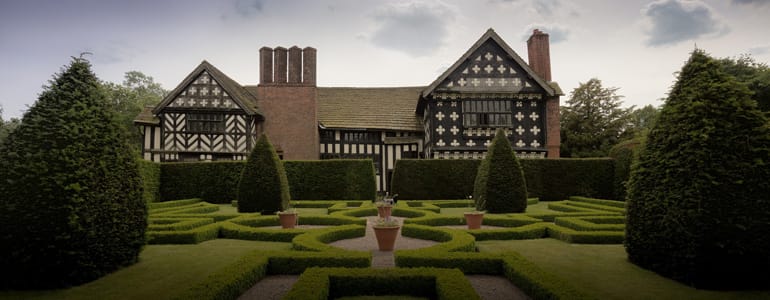
The distinctive architectural style of the 16th century drew inspiration from both the Gothic and Renaissance eras. These Tudor buildings typically had facades decorated in perpendicular black lines forming geometric shapes, a style which is now synonymous with the 1500s. However, gardens from this period were also inspired by this.
During the Tudor period, the primary function of a garden was for growing food, especially for those in lower socio-economic groups. Seasonal vegetables were grown on rotation in order to stave off hunger, and larger families meant that the range of food grown during this time needed to satiate even the hungriest of bellies. Beans, leeks and garlic were household favourites for this reason, as they could add flavour to any dish.
In addition to growing vegetables such as onions, the Tudors also appreciated the medicinal properties of herbs. Although many of the herbs that were cultivated were proven to be effective, a few highly-poisonous strains were also grown during this time. It was also through growing these varieties that they realised the many functions that herbs have, including being used as a colouring dye and in food.
“There’s a misconception that growing your own fruit and vegetables takes up a lot of space”, shares Marie from Plews Garden Design . “If we look at the smaller historical gardens, we could learn a few space-saving tricks to enable us to ‘eat our flower gardens’ and still have room for the children to play.”
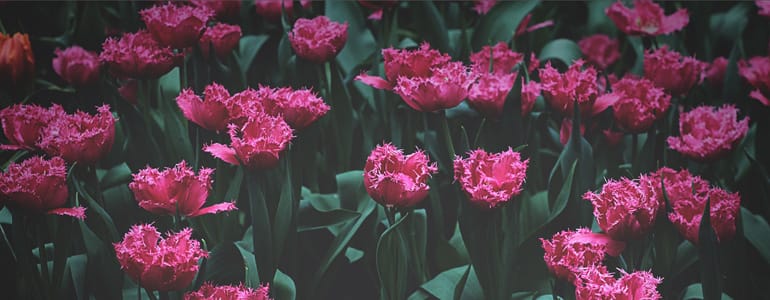
Blooming flowerbeds with vibrant carnations created a powerful perfume for those who enjoyed a stroll through the grounds of their house. According to Tudors Dynasty , the pops of pink were not uncommon and could often be found alongside the poppy, lavender and the yellow lupin, with species such as the African marigold and snapdragon introduced during King Henry VIII’s reign.
Throughout this period, displays of wealth were prevalent, with well-maintained gardens alluding to prominent status. The formal knot garden divided the space into geometric patterns to house the aforementioned herbs, a style which Marie from Plews Garden Design says that she loves. These entwined designs were often coloured with lavender and tinted gravel and attracted a plethora of butterflies due to the addition of perennial plants.
The Tudor’s loved symmetry. Each knot design would be meticulously measured, and a crosshatch of wooden slats known as lattice fence would often line the perimeter. Having the garden perfectly aligned was considered to have a calming effect, with the addition of water fountains providing ambience.
As many Tudor gardens were influenced by Italian architecture, water fountains became more prominent. Relying on gravity in order for the water to cascade down, they would tower above the knot gardens. Bodies of water became increasingly popular in landscape design with lakes, moats, and canals also being introduced to gardens.
The 1600s
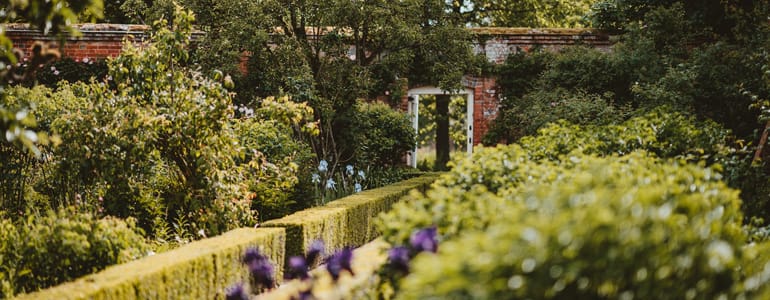
After the emerging trend of fountains and lakes in the 1500s, pleasure boats were soon introduced. This encouraged the move away from gardens as a place solely for relaxation to one of recreation and meant that people could enjoy spending time outside. Knot gardens began to evolve to baroque style, replacing Italian influence with that of French or Dutch. So, for those with wealth, their gardens oozed opulence, with spiral hedges and fancy water fountains.
Aside from using gardens as a recreational space, the growing of fruit, vegetables and herbs was still one of the main purposes of having a garden. As a result of this, gardens had evolved away from the decorative knot gardens of the Tudor period to walled gardens, as they made it easier to keep track of and monitor the growth of plants.
Having a sustainable source of food that you have grown locally is fantastic. We spoke to Lucy from The Smallest Smallholding , a blog that follows her journey growing her own fresh produce. This is the advice she offers for those who are currently considering growing your own food:
“Firstly, I would say, just do it! It will bring you great joy. I would really recommend considering what space you have and understanding your space before you start planning which fruit and vegetables to grow. It's a really important part of the permaculture principles – observation and understanding. This involves observing and understanding where the light and shade fall throughout the day and throughout the different seasons, where prevailing winds come from and what plants are already thriving in certain areas of your growing space. This is a great grounding for success, as it helps to choose the right plants for your patch. Essentially the goal is to work with nature, not against it. Take this approach, and you'll literally reap the rewards.
Start small and simple
“I would also advise starting small and simple. In my second season of growing, I made the mistake of diving in and trying too many things at once, which did not end well! Over the years, I've learned to manage expectations and try to only grow what I know I have time to tend. If you're really pressed for time, you can have great success with ‘easy wins’ like salad leaves, some soft fruit canes (Polka raspberries are very unfussy and always crop well), and peas and beans. Just keep up the watering and occasional feeding and you'll have a decent yield on your hands.
“Lastly, I would say maybe try some varieties that are local to you, or heirlooms: things you can't get in the shops. Most of the time, these less-common varieties are head and shoulders above any supermarket produce.”

Walled and Botanical Gardens
Along with herbs, the 1600 hail the emergence of botanical gardens, with the first opening in 1621. The Oxford Physic Garden started off as a walled garden with a variety of taxonomic beds and were "classified according to their medicinal properties". Botanical gardens are purpose-built to analyse and observe plant species, however, they also allow for plant conservation. During the 17th century, scientists became more intrigued by horticulture, so each botanical garden provided them with a space for research.
Having a walled garden meant that observing flowers grown from seeds became easier. This is something that Jasmine Groves, Head Gardener at English Heritage-owned Witley Court also loves “My favourite trend has to be ‘grow your own’. Not only are people now growing their own vegetables but flowers too. It doesn’t matter if you have only a small windowsill or if you are lucky enough to have a large back garden, everyone can have a go at growing their own flowers.
“Growing from seed is an excellent way of producing plants and is very cost effective. I always sow too many seeds, but this is a great way to share plants with friends. Swapping clumps of seedlings means that you can create an excellent display of flowers. However, you can also swap tips and see who grows the best all for the cost of one pack of seeds.”
The 1700s
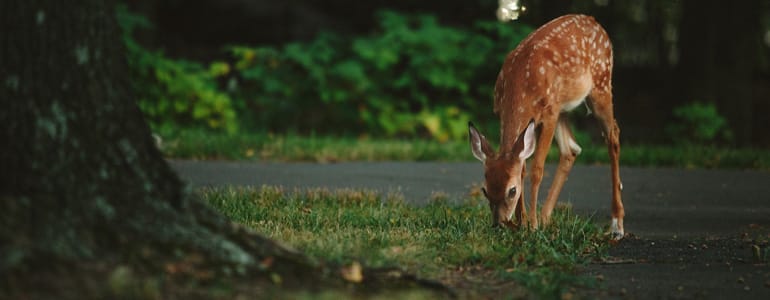
The 18th century continued to emphasise the trend of spending time outside for leisure and recreational purposes. Large deer parks made the perfect location for hunting, whereas circular walks were seen as fantastic ways to spend an afternoon. What’s more, due to more time being spent outside, gravel paths were introduced so as to not ruin the grass. Across the 1700s, dining times were constantly changing. With lunch-time getting later and rising Georgian desire to spend time more outside, the humble picnics was introduced.
The 18th century also allowed many households to make the transition from walled spaces for cultivating plants towards the sort of gardens that we would see today. This space was now seen as an extension of the home and was often well-maintained. For smaller spaces, potted plants were favoured as they could be moved around with ease but flower beds bursting with bulbs and powerful perfumes were also frequently found.
Following the success of botanical gardens in the 17th century, many gardeners were keen to introduce new species of plants into their own spaces. Exotic seeds from foreign countries began to infiltrate seed shops, greengrocers and street traders’ stalls; and due to the increasing demand, the first nurseries began to open during this time. The vibrant yellow of the Black-eyed Susan and the brilliant blue of the cornflower could be found during this time, having both arrived from America during the 1700s.
Kitchen gardens of the 18th Century were now bursting with new flavours. Myriad vegetables such as peas, cabbage and asparagus were readily available and incorporated into a number of dishes, and recipes for fruity desserts such as plum puddings were documented in many cookbooks. Rather than confining vegetables to small beds, trellises allowed for honeysuckle, and orchards boasting apple and pear trees provided fruity variety.
The 1800s
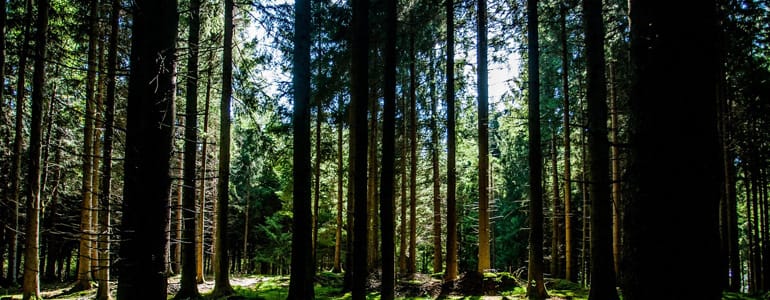
New technology of the 19th Century meant that the way that gardens were looked after changed. In 1830, the first lawnmower was invented by Edwin Budding. Its main use was to keep the lawn on sports pitches trimmed, however, it also allowed the grounds of larger homes to be kept looking presentable. Prior to this, it is believed that sheep were the primary means of keeping lawns short, so the introduction of Budding’s invention was welcomed and by 1920, lawnmowers were being mass produced.
The Invention of the Lanwmower
Jasmine from Witley Grove shared her thoughts about the technological advancements in grass cutting: “Grass cutting has evolved so much through the years. The scythe, which is still used today, is great for cutting long grass but it definitely requires skill to use. The pony-propelled mowers were great for mowing large areas, with the added bonus of free manure! However, we sadly don’t see many ponies mowing any more. The introduction of petrol and diesel mowers has certainly meant we can cut the grass faster than ever before. Not only are electric, battery-powered mowers quiet but also lightweight. Some of the newest models also don’t need a human to control them! These mowers happily set to work on the grass until they run low on battery when they simply need a recharge. In ten years’ time, who knows where we will be? Technology is positively helping gardening evolve and grow.”
Greenhouses and Cottage Gardens
In addition to technological advances making the maintenance of gardens easier, it also allowed the food industry to flourish. The shipment of fruit and vegetables became easier than ever before and also meant that plants could be guaranteed disease-free. The climate became increasingly important, and many began to notice the effects that temperature would have on cultivating different plants. So, with this in mind, the Wardian Case was created in 1829 after Nathaniel Bagshaw Ward noticed how well ferns grew when enclosed in a container with a constant climate.
Although greenhouses first emerged in the 1700s, they became more prominent during this century, especially due to horticulturist J.C Loudon who, according to Old House , “invented a wrought-iron sash bar, less brittle than cast iron and cheaper than wood, which could be curved for glass domes." These humid structures meant that a number of new plants could be grown. However, due to the high costs caused by the 1746 glass tax, they were limited only to the very wealthy.
In this period, the cottage garden seemed to be the biggest trend, with The Cottage Gardener magazine offering inspiration to those looking to grow their own. Gardens also became more prominent in literature and were idealised locations full of flower borders and pretty ponds. The Arts and Crafts Movement which emerged in the late 1800s developed a distinct style which is now evident in many gardens across the UK today. Contrasting the harsh colours of cottage bricks, a pastel palette provided a softness.
The Birth of the RHS
The horticultural and agricultural industries during the 19th century became increasingly popular and, during this period, the Royal Horticultural Society was founded. Started in 1804 by John Wedgwood, the RHS allowed for regular meetings to be held discussing new plant discoveries. Across the century, the RHS would obtain ownership of the Duke of Devonshire’s Chiswick estate, a garden in South Kensington, and a garden in Wisley.
Advances in photography meant that capturing the garden landscape of the UK became easier. Photography using silver halide was something that was being investigated in France by Jacques Louis Mandé Daguerre. However, it was UK-based scientist Sir John Herschel who made the discovery that sodium thiosulphate could be used as a solvent, allowing the images to develop properly and fix to the paper. In fact, his discoveries are still widely used according to Writing Through Light “in a black and white film and paper chemistry”.
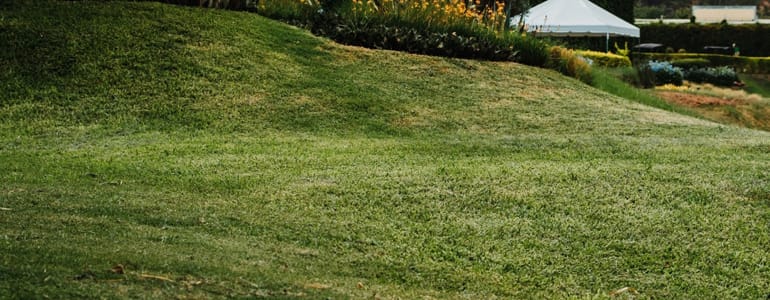
In regard to gardens, rockeries were a popular trend that emerged. We spoke to Ian Young from the Scottish Rock Garden Club , who shared with us the typical characteristics of a rock garden.
Rockeries of the 1800s
“Rock gardens have evolved from the time of the first ‘rockery’ where rocks often played a dominant decorative role to the more recent practice of imitating natural rock features such as crevice, scree or moraine. As well as being attractive, these features also improve the growing conditions for many small wild plants, usually from a mountain habitat, favoured by modern-day rock gardeners. Because gardens can be of any size, they are the ideal choice for the modern smaller size of garden and even if you do not have a garden you can place a rock garden container on the side of a pathway or step.
“There is no single definition for a rock garden; it can be whatever the gardener wants it to be. The visual effect of a rock garden will normally be enhanced by some well-placed rock which should serve to improve the aesthetics, as well as making the habitat more suitable for the plants. A rock garden can be any size from a small trough or container upwards where the size of the rocks would be in proportion to the overall scale.”
The 1900s

The 1900s saw a massive change in gardening. “Climate change is having a key impact” shares landscape gardener, Adam Vetere who is enthused by his continued passion for plants and sustainable design. “A shift towards sustainable gardening has been created. Designers and increasingly gardeners are beginning to understand the term ‘sustainability’, in so far as what it actually means”. He described sustainable gardening as:
“Having a minimal impact on the surrounding environment, working with the local ecology, creating clever plant communities which support wildlife and reduce maintenance, the introduction of more drought tolerant species into our gardens which help to conserve water and the smart use of landscaping materials, by sourcing locally and using more eco-friendly alternatives when available.
The use of chemicals is reducing, gardeners are looking for organic or eco-friendly alternatives, peat usage is being drastically pulled back and even plant pots are now being designed to be recycled. We all have our part to play, including designers and gardeners.”
Minimalism in Gardening
During this time, minimalism was an emerging trend in both interior and exterior design. Nicola from The Bonnie Gardener defines a minimalist garden as: “Simple and elegant. When I think of a minimalist garden I think of structural and evergreen plants - perhaps Buxus or Yew topiary, shaped like cones or spheres. I also think of plants like Bamboo and simple grasses that move in the wind like Stipa. A minimalist garden can be very contemporary, suited to a city penthouse for example, or it can be traditional - a lawn filled with Yew cones at a stately home. The hard landscaping elements are usually simple, with slate and dark grey stone. And furniture tends to be built around straight lines and minimal detail, rather than something like Gothic design.”
“There are lots of ways gardening has changed and become less labour intensive, particularly through the use of machinery for tasks such as hedge trimming and grass cutting. There is, sadly, also a huge use of chemicals for weed killing and controlling pests. However, I like to think that gardening itself - the use of simple tools such as hoes, forks, spades and sheers - has remained largely the same over the centuries. Gardening is all about tending to plants and giving them the conditions that they need to thrive - that was the same 200 years ago. I also think gardening is about sharing information - tips, seeds, good cultivars - that continues to be the motivation for gardening clubs, allotments, etc. It is a simple activity that brings a huge amount of pleasure.”
Post-war Gardening – Dig for Victory!
World War I and World War II meant that the English landscape needed to be revolutionised. In order to feed the population, victory gardens were introduced. These allotment-style gardens would allow communities to come together in order to grow produce which could be shared across the towns and villages. Not only did this allow food to go further in a time where rations were incredibly low, but it also boosted the morale of many who were living through this treacherous time.
Campaign slogans such as ‘Dig for Victory’ emerged, offering those with no gardening experience tips and advice on growing crops. Newspapers would highlight the importance of growing your own and would include information on how to improve the quality of your soil in addition to preparing allotments for the upcoming season. In the space of a couple of years, the number of allotments across the country rose from around 740,000 to 1,400,000, according to Allotment Resources.
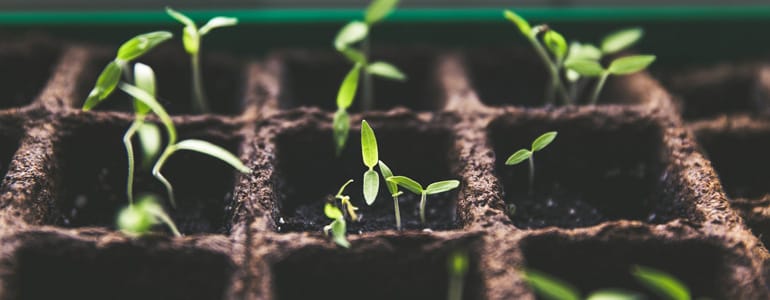
Post-war gardens became a place to seek solace. Peaceful and tranquil spaces, an ornamental style meant that a rainbow of flowers could be found decorating outdoor spaces, injecting colour to a country after a dark period. These ornamental gardens transformed the desolate landscape. With plants and flowers chosen specifically for their appearance, these spaces were aesthetically pleasing, with foliage and shrubs, as well as manicured hedges and flower beds.
The Diversity of Gardens
“Gardening has evolved and diversified in so many incredible ways”, shares Suzy from English Country Gardeners. “Traditional gardens and historic gardens have been maintained throughout the years and still remain popular. However, with the availability of media, the internet and today’s technology gardeners and garden owners have access to so many new ideas and choices. The influence of culture and art has introduced new garden styles such as Zen gardens with Japanese bridges and water features, Italian gardens with extensive topiary and so many more. Non-native plants have also become more attainable in today’s world.”
“For both health and environmental reasons, gardening increased in popularity. Studies have shown that gardening promotes physical and mental health. This has led to the development of public green spaces, accessibility to parks and gardens for all, and the promotion of various programmes and schemes such as private garden visiting. Boundaries are constantly being pushed within gardening and ways to explore those opportunities. In cities, urban gardens are becoming increasingly popular where confined spaces are being utilised and maximised to provide homes with a natural space.”
The 2000s

Sustainability continued to emerge as one of the biggest trends in gardening during the 21st Century, with many homes now including a space for cultivating plants for food once more. Lucy from The Smallest Smallholdings is a great advocate for sustainable gardening, and has let us know what it means to her:
“Sustainable gardening, to me, means working with nature and not against it - swapping weed killer and pesticides for a bit of elbow grease and natural alternatives. Companion planting, sacrificial plants like nasturtiums, and the management of a welcoming environment for natural predators like birds, hedgehogs, frogs and ladybirds help us to address a balance where nature really takes care of itself, and we're not waging war to protect our fruit and veg harvests. It also means, where possible, creating a closed loop system so that you're not continually relying on outside sources and manufacturing. This can be as simple as making your own compost, avoiding plastic pots and packaging by taking cuttings or seed saving/swaps, and using natural, ideally locally-sourced, materials in the garden, such as hazel poles or willow plant supports. “
Environmental Gardening
Suzy from English Country Gardeners also shared her thoughts about the evolution of gardening: “Environmental awareness in gardening is not a new trend but is something that changes over time in relation to new knowledge. It has been a consideration of homeowners, designers and landscape managers for many years, irrespective of the style of garden involved. Designers such as Capability Brown in the 18th Century through to Tom Stuart Smith today, for example, each pay particular attention to the use of natural styles, open vistas and species choice in their designs.”
“This approach is far from limited to the aesthetics of the garden; the use of native plant species, chemical-free pest/weed control, composting, rainwater storage systems and improved consideration for animal species’ seasonal habits, to name a few, are now common considerations as the public become increasingly aware of our impact on the natural ecosystem. Such practices can be seen in the country’s most formal private estate gardens, and small domestic gardens, through to expansive rewilding projects and council-owned open spaces. This is not a new trend, but one that evolves with our knowledge of our impact on the natural world and is, therefore, a favourite industry trend among all here at English Country Gardeners.”
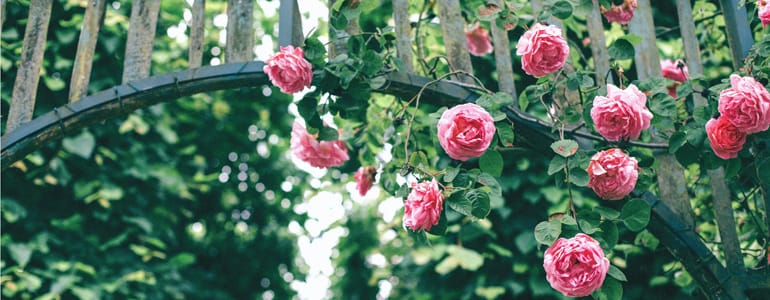
According to landscape designer Adam, new trends have emerged over the past couple of decades. “Trends are fascinating. Planting design has evolved immensely since the 1990s, with the New Perennial Movement, Modernist Schemes, Steppe and Prairie Design, all becoming the choice of the 21st Century. The other key trend is the understanding of how a garden can help with both the physical and mental health wellbeing of all of us. This is a huge area for designers to focus their skills on and one which will evolve and grow significantly over the coming years.”
With the increasing demand for housing, the amount of garden space per house has decreased significantly. Urban areas are now increasingly tarmacked in order to make room for more accommodation. As a result of this, indoor gardening has become popular. From cacti to terrariums, house plants allow those living in built-up cities to inject plant life into their homes.
Gardening through Climate Change
Additionally, environmental changes now have to be taken into consideration due to the rising temperature of the earth: “Climate change is having a key impact, as the diversity of plants which can be used in Southern England (my patch!) is astonishing. I am freely using a variety of palms, olives and other Mediterranean plants which would never have survived the winters of the 1980s, plus Dahlias, Cannas, Hedychiums and Musa Basjoo can be wintered safely in the ground, without having to lift dry store and then replant. This, in turn, reduces the amount of maintenance and work, which when added to the trends of steppe and clever prairie style planting over the last 10-20 years creates a more sustainable method of gardening. Last summer (one of the hottest and driest on record), I never once had to water my Mediterranean terraces!
The changing landscape also has made an impact on the wildlife of the country, with more plants being introduced in order to sustain the numbers of bees and insects. “From a wildlife perspective, there is much more information available to people and many more options for purchasing plants and seeds to benefit wildlife. Because of this, people are more aware and more inclined to garden for wildlife now than before”, shares Helen from the Bumblebee Conservatory . “There are literally hundreds of bee-friendly plants to choose from, which is why we produced our free online educational gardening tool, Bee Kind.
“Bee kind can recommend the bee-friendly plants which will work best in your garden. Ideally, you should aim to have something in flower from March, right through to October. Flowering currants, heathers, lavenders, rosemary and marjoram are great low maintenance plants to start with.”








